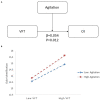Interactive Effects of Agitation and Cognitive Impairment on Odor Identification in Patients With Late-Life Depression
- PMID: 35350425
- PMCID: PMC8957811
- DOI: 10.3389/fpsyt.2022.839012
Interactive Effects of Agitation and Cognitive Impairment on Odor Identification in Patients With Late-Life Depression
Abstract
Background: Late-life depression (LLD) is a risk factor for cognitive decline in older adults, and odor identification (OI) deficits are an early indicator of cognitive decline with LLD. However, neuropsychiatric symptoms (NPSs) are common in LLD and are associated with OI deficits. In subjects with LLD, when OI deficits forecast cognitive decline, whether and how NPS affects the relationship between OI and cognition still must be further explored.
Objective: To comprehensively explore the potential effects of various NPSs on the relationship between OI and cognition in participants with LLD.
Methods: There were 167 patients with LLD and 105 normal elderly (NE) participants. The odor identification test (Sniffin' Sticks), cognitive function assessments (global cognition, memory, executive function, attention, language, visual space), and an NPS assessment (the neuropsychiatric inventory questionnaire) were performed on the subjects. In patients with LLD, the relationship among OI, cognition and NPSs was examined using correlation analysis and moderation analysis.
Results: In patients with LLD, OI was positively correlated with cognition (global cognition, memory, executive function, attention, language) and negatively associated with NPSs (agitation and aberrant motor behavior). In NE group, OI was correlated with executive function. Moderation analysis showed that there was an interactive effect of agitation and cognitive impairment (language deficit or attention deficit) on OI in patients with LLD.
Conclusion: The coexistence of agitation and language or attention deficit was associated with worse OI in subjects with LLD. Agitation should be considered since OI predicts cognitive decline in patients with LLD.
Keywords: Alzheimer's disease; agitation; cognition; late-life depression; neuropsychiatric symptoms; odor identification.
Copyright © 2022 Zhang, Chen, Zhong, Zhang, Wang, Wu, Hou, Zhou, Chen, Liu, Yang, Lin, Hummel and Ning.
Conflict of interest statement
The authors declare that the research was conducted in the absence of any commercial or financial relationships that could be construed as a potential conflict of interest.
Figures



Similar articles
-
Odor identification dysfunction in late-life depression with suicidal ideation.J Affect Disord. 2024 Dec 15;367:768-776. doi: 10.1016/j.jad.2024.08.227. Epub 2024 Sep 2. J Affect Disord. 2024. PMID: 39233243
-
Disrupted olfactory functional connectivity in patients with late-life depression.J Affect Disord. 2022 Jun 1;306:174-181. doi: 10.1016/j.jad.2022.03.014. Epub 2022 Mar 13. J Affect Disord. 2022. PMID: 35292309
-
Neuropsychiatric Symptoms Mediated the Relationship Between Odor Identification and Cognition in Alzheimer's Disease Spectrum: A Structural Equation Model Analysis.Front Aging Neurosci. 2022 Jan 12;13:732840. doi: 10.3389/fnagi.2021.732840. eCollection 2021. Front Aging Neurosci. 2022. PMID: 35095464 Free PMC article.
-
Late life depression with cognitive impairment: evaluation and treatment.Clin Interv Aging. 2009;4:51-7. Epub 2009 May 14. Clin Interv Aging. 2009. PMID: 19503765 Free PMC article. Review.
-
Late-Life Depression, Cognitive Impairment, and Relationship with Alzheimer's Disease.Dement Geriatr Cogn Disord. 2021;50(5):414-424. doi: 10.1159/000519453. Epub 2021 Nov 25. Dement Geriatr Cogn Disord. 2021. PMID: 34823241 Review.
Cited by
-
Risk Factors Influencing Cognitive Function in Elderly Patients With Late-Life Depression: A Scoping Review.Brain Behav. 2025 Jan;15(1):e70265. doi: 10.1002/brb3.70265. Brain Behav. 2025. PMID: 39789762 Free PMC article.
-
Olfaction and declarative memory in aging: a meta-analysis.Chem Senses. 2023 Jan 1;48:bjad045. doi: 10.1093/chemse/bjad045. Chem Senses. 2023. PMID: 37878784 Free PMC article.
-
Primary Hypothyroidism and Alzheimer's Disease: A Tale of Two.Cell Mol Neurobiol. 2023 Oct;43(7):3405-3416. doi: 10.1007/s10571-023-01392-y. Epub 2023 Aug 4. Cell Mol Neurobiol. 2023. PMID: 37540395 Free PMC article. Review.
-
Olfactory Dysfunction and Depression Trajectories in Community-Dwelling Older Adults.J Gerontol A Biol Sci Med Sci. 2024 Jan 1;79(1):glad139. doi: 10.1093/gerona/glad139. J Gerontol A Biol Sci Med Sci. 2024. PMID: 37357824 Free PMC article.
References
LinkOut - more resources
Full Text Sources

